

Rise of Broadcast (Lecture 20) Media unlimited: how the torrent of ... History of Television - Archive Collection. A Science Odyssey: People and Discoveries: KDKA begins to broadcast. KDKA begins to broadcast1920 Photo: Beginnings of KDKA, with entire staff of four On Christmas Eve, 1906, wireless operators on ships off the New England coast wondered if they'd had a religious experience.

Charles Coughlin. Charles Edward Coughlin, commonly known as Father Coughlin, (October 25, 1891 – October 27, 1979) was a controversial Roman Catholic priest at Royal Oak, Michigan's National Shrine of the Little Flower church.

He was one of the first political leaders to use radio to reach a mass audience, as possibly thirty million listeners tuned to his weekly broadcasts during the 1930s. Early life and work[edit] Coughlin was born in Hamilton, Ontario, to Irish Catholic parents, Thomas J. Coughlin and Amelia Mahoney.[8] After his basic education, he attended St. Old-time radio. Before television, radio was the dominant home entertainment medium.
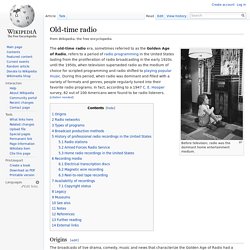
The old-time radio era, sometimes referred to as the Golden Age of Radio, refers to a period of radio programming in the United States lasting from the proliferation of radio broadcasting in the early 1920s until the 1950s, when television superseded radio as the medium of choice for scripted programming and radio shifted to playing popular music. During this period, when radio was dominant and filled with a variety of formats and genres, people regularly tuned into their favorite radio programs.
In fact, according to a 1947 C. E. Hooper survey, 82 out of 100 Americans were found to be radio listeners. Documenting Early Radio. DOCUMENTING EARLY RADIOA Review of Existing Pre-1932 Radio RecordingsBy Elizabeth McLeod For most people the term "early radio" is used pretty loosely...anything before the introduction of format radio in the fifties would qualify, and certainly anything involving drama, comedy or variety programming.
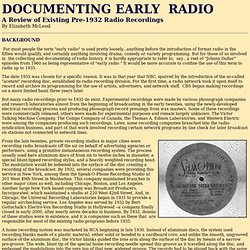
But for those of us involved in the collecting and documenting of radio history, it is hardly appropriate to refer to, say , a reel of "Johnny Dollar" episodes from 1960 as being representative of "early radio. " It would be more accurate to confine the use of this term to radio up to 1935. The Rise of Radio. By Marc Fisher Random House. 374 pp. $27.95 Ear-splitting static was the curse of AM radio in its formative decades.
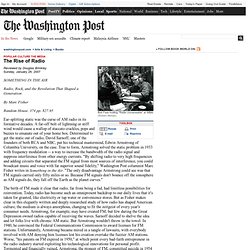
A far-off bolt of lightning or stiff wind would cause a wallop of staccato crackles, pops and buzzes to emanate out of your home box. Between the Wars: Radio. New technologies have often ended up with very different uses than their inventors intended.
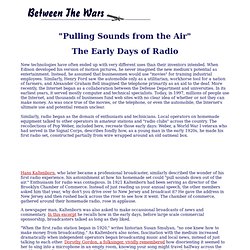
When Edison developed his version of motion pictures, he never imagined the new medium's potential as entertainment. Instead, he assumed that businessmen would use "movies" for training industrial employees. Similarly, Henry Ford saw the automobile only as a utilitarian, workhorse tool for a nation of farmers, and Alexander Graham Bell imagined the telephone primarily as an aid to the deaf. More recently, the Internet began as a collaboration between the Defense Department and universities.
The War of the Worlds (radio drama) The War of the Worlds is an episode of the American radio drama anthology series The Mercury Theatre on the Air.
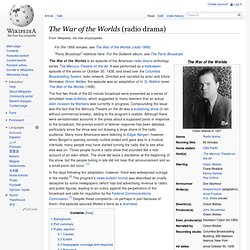
It was performed as a Halloween episode of the series on October 30, 1938, and aired over the Columbia Broadcasting System radio network. Directed and narrated by actor and future filmmaker Orson Welles, the episode was an adaptation of H. G. Federal Radio Commission. Federal Communications Commission. The FCC was formed by the Communications Act of 1934 to replace the radio regulation functions of the Federal Radio Commission.

The FCC took over wire communication regulation from the Interstate Commerce Commission. The FCC's mandated jurisdiction covers the 50 states, the District of Columbia, and U.S. possessions. The FCC also provides varied degrees of cooperation, oversight, and leadership for similar communications bodies in other countries of North America. The FCC is funded entirely by regulatory fees. It has an estimated fiscal-2011 budget of US$335.8 million and a proposed fiscal-2012 budget of $354.2 million. Mission and strategy[edit] Public broadcasting. Public broadcasting includes radio, television and other electronic media outlets whose primary mission is public service.
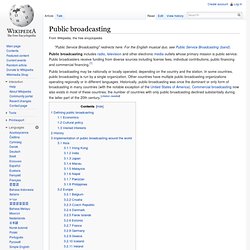
Public broadcasters receive funding from diverse sources including license fees, individual contributions, public financing and commercial financing.[1] Public broadcasting may be nationally or locally operated, depending on the country and the station. In some countries, public broadcasting is run by a single organization. Other countries have multiple public broadcasting organizations operating regionally or in different languages. Media and the American Mind. History of radio. The early history of radio is the history of technology that produced radio instruments that use radio waves.
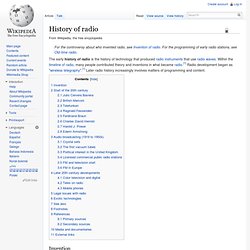
Within the timeline of radio, many people contributed theory and inventions in what became radio.[1] Radio development began as "wireless telegraphy".[1] Later radio history increasingly involves matters of programming and content. Invention. United States Early Radio History. Rise of Mass Communications (Lecture 19) Propaganda. Propaganda is a form of communication aimed towards influencing the attitude of a population toward some cause or position. While the term propaganda has acquired a strongly negative connotation by association with its most manipulative and jingoistic examples, propaganda in its original sense was neutral and could refer to uses that were generally positive, such as public health recommendations, signs encouraging citizens to participate in a census or election, or messages encouraging persons to report crimes to law enforcement. Etymology[edit] Triumph des Willens (Full movie - English subbed)
Frank Capra's "Why We Fight" World War II Propaganda Series. Why we Fight. -----------OVER 530 Videos UPLOADED---------- The purpose of this You Tube site is to provide interested viewers with past documentaries concerning World War II. Many documentaries date from World War II or proceeding years after. Many have quite startling interviews and information. Most earlier documentaries are laced with propaganda, but that can be filtered through. These videos are all public domain videos. AdamicGlanceBlogWWW.pdf (application/pdf Object) Media Research Center. Muckraker. McClure's (cover, January 1901) published many early muckraker articles.
The term muckraker was used in the Progressive Era to characterize reform-minded American journalists who attacked established institutions and leaders as corrupt. They typically had large audiences in some popular magazines. In the US, the modern term is investigative journalism — it has different and more pejorative connotations in British English — and investigative journalists in the USA today are often informally called 'muckrakers'.
Muckraking magazines—notably McClure's of the publisher S. S. The muckrakers played a highly visible role during the Progressive Era period, 1890s–1920s.[2] In contemporary American use, the term describes either a journalist who writes in the adversarial or alternative tradition, or a non-journalist whose purpose in publication is to advocate reform and change.[3] Investigative journalists view the muckrakers as early influences and a continuation of watchdog journalism. Nellie Bly. Early years[edit] Nellie Bly working in a factory producing boxes At birth she was named Elizabeth Jane Cochran. She was born in "Cochran Mills", today part of the Pittsburgh suburb of Burrell Township, Armstrong County, Pennsylvania.[4][5][6] Her father, Michael Cochran, was a modest laborer and mill worker who married Mary Jane.
Penny press. History[edit] As the East Coast's middle and working classes grew, so did the new public’s desire for news. Penny papers emerged as a cheap source with coverage of crime, tragedy, adventure, and gossip. Yellow journalism. Yellow journalism, or the yellow press, is a type of journalism that presents little or no legitimate well-researched news and instead uses eye-catching headlines to sell more newspapers.[1] Techniques may include exaggerations of news events, scandal-mongering, or sensationalism.[1] By extension, the term yellow journalism is used today as a pejorative to decry any journalism that treats news in an unprofessional or unethical fashion.[2] Definitions Joseph Campbell defines yellow press newspapers as having daily multi-column front-page headlines covering a variety of topics, such as sports and scandal, using bold layouts (with large illustrations and perhaps color), heavy reliance on unnamed sources, and unabashed self-promotion.
The term was extensively used to describe certain major New York City newspapers about 1900 as they battled for circulation. Crucible Of Empire : The Spanish-American War - PBS Online. Dime novel. Inverted pyramid. Stereotype (printing) Pitman shorthand. History of journalism. Freedom's Journal, the first African-American owned and operated newspaper published in the US.
International History of Journalism - Mitchell Stephens. The Impact of Photography (Lecture 18) Selected Civil War Photographs Home Page. All images are digitized | All jpegs/tiffs display outside Library of Congress | View All This online collection provides access to about 7,000 different views and portraits made during the American Civil War (1861-1865) and its immediate aftermath. Mathew Brady. Mathew B. Beaumont Newhall. Beaumont Newhall - Dictionary of Art Historians. Civil War Photography. Photography and the Civil War, 1861–1865. 10 Most Famous Doctored Photos - Oddee.com (famous photographs, fake photos...) Urban Legends Reference Pages: (John Kerry) Reading Susan Sontag's On Photography home page. Sontag_platos_cave.pdf (application/pdf Object) Daguerreotype. Daguerreotypes: Special Presentation. Camera obscura. Photojournalism. [Get the Picture: Personal Photojournalism. Get the Picture: A Personal History of Photojournalism (Crime & Justice: a Review of Research; Crime & Justice: a Review of Research) (9780226539140): John G. Morris.